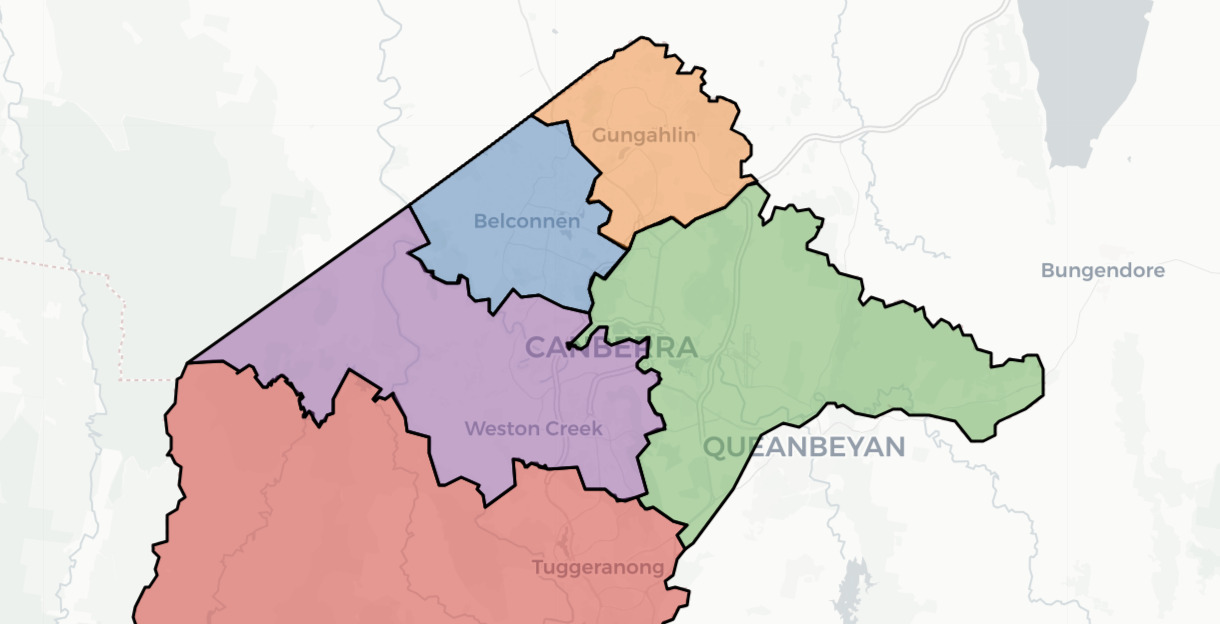I have been watching the last week of counting in the ACT election, which eventually made it clear that the Greens’ Laura Nuttall would retain the final seat in Brindabella, despite her own party conceding defeat on election night, and that Liberal MP Ed Cocks would narrowly hold on against another Liberal in Murrumbidgee. I haven’t been able to actively post in part because I’m away on a family holiday. But today I wanted to use some analytical tools I developed for this Tasmanian election blog post to look at how preferences play out under the ACT elections (at least since the introduction of the 5×5 system in 2016) and how the final rounds of preferences played out in Brindabella and Murrumbidgee.
The ABC called Brindabella for Nuttall on Wednesday night, and I agree with that, but as of Thursday night the interim distribution of preferences are close enough to all of the votes that have had their #1 preference counted that it makes the analysis a bit simpler.
The most interesting race was Brindabella. In this seat, we almost saw Labor win them three seats despite barely polling over two quotas, thanks to a combination of the Ginninderra Effect and strong preference flows between the non-Liberal parties.
At they key point, after the distribution of the surplus from second Liberal Morris, four candidates were close in the race for the last two seats: second Labor Werner-Gibbings on 0.73, third Liberal Daniels on 0.72, Greens Nuttall on 0.70 and third Labor (and sitting MP) Mick Gentleman on 0.64.
The three Labor candidates at this point were on 0.96, 0.73 and 0.64. That’s 2.33 quotas between them. They had started on 2.0 quotas, but had gained preferences from a variety of candidates, including Independents for Canberra. When the final IFC candidate was knocked out, the three Labor candidates gained 0.16 quotas between them. Incidentally this is also true for Nuttall. The combined Greens vote started at 0.5 quotas, but by this point Nuttall was on 0.70.
But if the Labor vote was more concentrated with the first two, Gentleman wouldn’t have come close. That’s the Ginninderra Effect.
So at this point Gentleman is knocked out, and the third Liberal is 0.02 quotas ahead of Nuttall. Nuttall does benefit a little from Gentleman’s preferences, and closes that gap to 0.01, but most of Gentleman’s votes split evenly between his two Labor colleagues, electing Tough with a substantial surplus and bringing Werner-Gibbings close to a quota.
Tough’s surplus then elects Werner-Gibbings (and pushes Nuttall 0.01 quota ahead of her Liberal rival). Werner-Gibbings then has a surplus. A majority of the 0.18 surplus exhausts, but Nuttall gained 0.03 quotas to just 0.01 to the Liberal, putting her in a small but clear lead.
These figures aren’t final, but they are close. There’s no chance Gentleman could get back in the race, and Nuttall should be fine.
The other race of interest was in Murrumbidgee, where half-term Liberal MP Ed Cocks had a close call from his Liberal rival Armandeep Singh.
For this chart I’ve just shown the three main contenders to keep things simple.
The crucial issue in this count, which Kevin Bonham identified in the podcast, was whether the Greens candidate was knocked out before or after the point where it was decided which Liberal would proceed to win. If the Greens were knocked out earlier, their preferences elected the Labor candidates and then that surplus favoured Singh slightly. But the improving Greens position meant Singh was knocked out first.
Related to this, I’ve also looked at what share of the primary vote for a party group translated into a particular number of seats.
It turns out the Nuttall result was truly exceptional. Since 2016 (when the 5×5 system was introduced), no candidate has won when their party group has polled as little as the Greens polled in Brindabella. Just looking at Labor, Greens, Liberal and IFC, vote shares of up to 0.58 quotas have not been enough to win.
The Liberal performances in Kurrajong in 2020 and 2024 were exceptional for the highest vote to only produce one seat. And the Liberal result in Brindabella, with 2.58 quotas, is the highest vote to not produce a third seat.
This final chart was the most intensive in collecting data. It looks at how many votes were gained by each party throughout the count, and how many leaked out while there were still candidates for that party to receive the votes (ie not when the last candidate is elected or excluded).
Liberals tend to suffer greater leakage. Interestingly IFC’s leakage rates didn’t rank as highly as I had heard – I’m not sure if I’m missing something in my data collection here. All the parties tend to gain votes at similar rates, but Labor and Greens leak less.
That’s it for today. I’ll put up an open thread for the Victorian council elections tomorrow, and otherwise I’ll be back at 6pm Queensland time tomorrow night for the Queensland state election.



